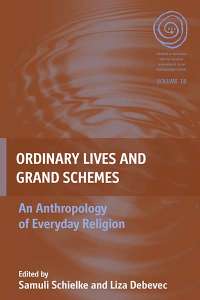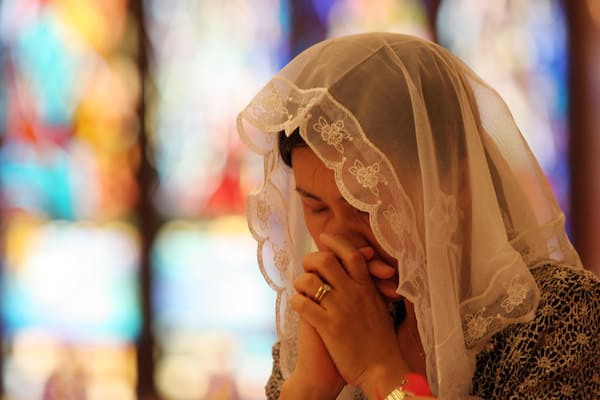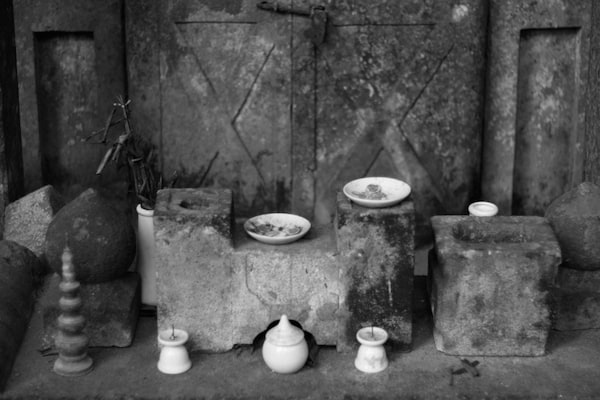The reviewed volume tackles the question of “how to account for the complex duality of religion as an everyday practice and a normative doctrine.” The editors, Samuli Schielke and Liza Debevec, argue that we take the everyday practice of religion as a starting point in dealing with this question: a Muslim diviner in the Senegambia who looks at some cowrie shells, a woman who rubs family photographs on the tomb of a saint in southern Italy, Egyptian youths who listen to dance songs, and farmers on Apiao who invite each other over for dinner. All are engaged in “little practices” through which they relate to and make sense of the “grand schemes” of their religion.
Ordinary Lives and Grand Schemes. An Anthropology of Everyday Religion. vi, 168 pp., bibliogr., index. New York, Oxford: Berghahn Books, 2012.
60.00 $ (hardcover). ISBN 978-0-85745-506-2.
Edited by Schielke, Samuli & Liza Debevec
The questions raised and tackled by the contributors are central to the study of religion, their general argument – that we should take people’s everyday practices to make sense of the world – is not only compelling; it opens up long-needed spaces to rethink our established categories in dealing with religion, including the conventional notion of “religion” itself.
The volume deals with the religious practices of those who are usually considered as laypeople. In their everyday religion, these people relate to each other, the divine, saints, their ancestors and religious institutions. They uphold, transmit, and contest their religious traditions, and they attempt to come to terms with their existential issues, hopes, and expectations. Thereby, they relate and contribute to the grand scheme of their religious tradition and attempt to make sense of their lives.

Samuli Schielke demonstrates for the case of Egypt, how the Islamic revival and neoliberal capitalism have emerged together and mutually influenced each other since the 1970s. Both “involve a sensibility of living in the future tense” (p.142): capitalism with its stress on profit and consumption, and the Islamic revival with its focus on reward. However, the promises of both are transient. The capitalist one is literally consumed in its fulfillment, and the notion of religious reward leaves one constantly insecure about one’s achievement. Hence, these grand schemes open at once on the hopeful and the tragic. Liza Debevec points out that one’s life situation can conflict with the religious ideals one adheres to. Moderate Muslims in urban Burkina Fasso postpone their involvement in prayer, as “postponing piety does not draw piety itself into question” (p.44).
Especially young, unmarried men do not make prayer a priority, as they have to struggle with the constraints of a complex life under economically harsh conditions. They become more involved in prayer only after marrying, as a way to establish themselves as adult members in their community. This involvement grows with age, when they wish to secure access to Heaven.
However, their postponement of prayer does not entail a rejection of what they take as “a matter of being Muslim” (p.33), but rather enables them to postpone dealing with this conflict.
How religious practices can integrate conflicting issues, is discussed by Jennifer Peterson in her essay on mulid festivities and the mulid dance songs in Egypt. Bothcombine spiritual and secular aspects. The sound of these songs “shifts between the piously moral and the jadedly tough” (p.120) and thus speaks to the conflicting desires of Egypt’s street-smart youths who provide the fan base of this music. These youths wish to follow both: Islamic moral ideals and a desire for pleasure and worldliness. Rather than contesting its Islamic framework, this music negotiates how to have fun and to secure one’s place in Heaven. In mulid dance songs, Islamic ideals are inseparably bound up with people’s desires.
Such an entanglement of religious ideals and everyday practices is likewise stressed in the Christian case studies. Giovanna Bacchiddu writes about Catholics in Apiao on the Chilean coast whose “religious affiliation is inextricably tied to their moral universe” (p.70) and contained in their daily deeds where reciprocity and hospitality take a prominent place. One becomes a proper Christian through enacting these values in everyday practice, thereby partaking in the community. This derives from local traditions and cosmologies rather than from the Church. The people of Apiao have thus “vernacularized” Christianity by reaffirming their local values within the framework of this institution.
Alison Marshall depicts how everyday religious practices are central to the formation and maintenance of the specific community where they take place and acquire meaning. In her history of “Frontier Confucianism” (p.49), she presents how Chinese migrants in early 20th century Canada came to integrate Chinese nationalist ideals with Confucian and Christian beliefs and practices in their daily religious practices. They have thereby created a space for individual agency and a basis for their migrant community. However, these remain rooted in the ambiguities entailed by this historic integration.
Evgenia Mesaritou stresses the agency of “ordinary” persons in her chapter on pilgrims to the shrine of Padre Pio in Italy. The Church has attempted to control the saint’s charisma through the material structure it has erected around the shrine. Conversely, the pilgrims have re-appropriated this space through their devotional practices without openly challenging the Church. The pilgrims establish personal relations with the saint that escapes the control of the Church, though they take place within its material structure, which imposes certain limitations. The “religious void” (p.98) of the pilgrimage site is thus invested with various practices and meanings, by both, the pilgrims and the Church, thereby contributing to the making of the saint.
Séverine Rey describes similar dynamics for the Orthodox Church on Lesvos where the Church had to accommodate three saints of the people in the 1960s. The Church had to accept and integrate as “stories of the simple people” what it had first rejected as “women’s tales” (p.94). While the Church tried to canonize what it had not initiated, the faithful attempted to give their lives and daily experiences significance, and found it in the figures of the saints and their relations with them. For the people, these saints are less canonical figures than “concrete models to follow and to identify with” (p.83).
All the studies focus on “actual lived experiences and their existential significance for the people involved [in these] little practices” (p.2). They furthermore show that these practices cannot be reduced to “popular religion” or to “little traditions” that derive from a “Great Tradition” (pp.3-4).
Here, the grand schemes and the actual lives of the people come together and co-constitute each other – often in contradiction. In their rituals and other acts, the people make “use” of the spaces provided and constrained by their religious traditions, institutions, and hierarchies, and thereby (co)constitute these. In their little practices, the people relate to the divine, which is principally an open and ambiguous endeavor.
In accordance with Orsi, these studies challenge our established analytical approaches to religion. The described practices appear as “off-modern [and] illustrate the multiplicity of temporalities that coexist within the modern and contemporary” (p.149), thereby calling into question the (analytical, normative, and descriptive) category of “modern religion.” These practices are ways and means by which the people (re)appropriate the “dominant religious idioms of their cultures” (p.150) and thereby participate in and contribute to these. The studies demand for a reassessment of our established analytical dichotomies – sacred/profane, us/them, and presence/absence of the divine – as these are inextricably intertwined in the presented practices. As Orsi argues, “religion situates practitioners in webs of relationships between heaven and earth, living and dead, and in rounds of stories” (p.151), and “religion in everyday life is abundantly intersubjective and relational” (pp.156-157). Our contemporary world is anything but disenchanted, as the divine is present and encountered in these practices apart from the human imaginations and bodies out of which it arises. As “religion” is embedded in the life world of people, their everyday practices, and their attempts to make sense of their lives, we should begin with their “manifold paths of daily lives” (p.152) in dealing with this phenomenon.
The great merit of this book consists in taking the practices of the people “on the ground” into account. It thereby addresses a gap: the moments when grand schemes and daily practices come together, often in contradiction or in complex and open ways.
These are otherwise reduced to the dichotomy of “popular vs. high religion” and thereby misrepresented. Religion is not a dichotomous affair; it rather consists in the manifold practices, hopes, and disappointments, as well as attempts to make sense of one’s live that are waged by “ordinary” people in relation to the grand scheme of their religion which is (re)made through these very acts. This is competently conveyed in this compelling and inspirational volume.

The authors’ phenomenological approach to religion aims at a more nuanced understanding of the everyday religious practices of people on the ground. Human subjects are not reducible to their piety but (possibly) striving toward it in more complex lives (pp.6-7). Nor are these practices ascribable to individual agency or a religious structure. People make use of the limited spaces for action provided by their grand schemes, thereby (re)making these (pp.8-11). In the studies of this thought-provoking volume, “everyday religion […] becomes those occasions when humans in the mundane circumstances of their lives engage and are engaged by the gods along with all the media […] of real presence” (p.156), as Robert Orsi puts it in his afterword.




